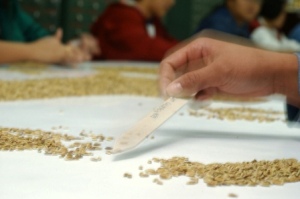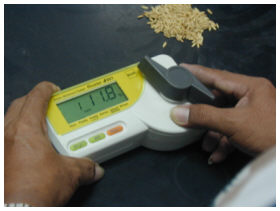Sample processing in seed banks of wild rice and related genera genetic resources
Contributors to this page: T.T. Chang Genetic Resources Centre-IRRI, Los Baños, Philippines (Ruaraidh Sackville Hamilton, Ken McNally, Flora de Guzman, Renato Reaño, Soccie Almazan, Adelaida Alcantara, Elizabeth Naredo); WARDA, Cotonou, Benin (Ines Sánchez); UPLB-University of the Philippines at Los Baños (Teresita Borromeo).
|
Contents: |
Cleaning is the removal of physical contamination from the plant material after harvesting, before it can be stored. The exposure to unfavourable conditions should be minimized for greater seed longevity in storage.
- Immediately after harvesting, the panicles should be dried (see details below) and kept inside the drying room for two weeks.
- Wild species are highly shattering thus panicles should be bagged to collect the seeds.
- Then they should be carefully hand threshed (this is necessary to maximize seed production) and cleaned.
Visual inspection of seeds
 IRRI staff selecting good seeds for storage to the IRRI Genebank facility (photo: IRRI) |
- Verify the sample comparing it with the seed file.
- Determine the selection to be carried out based on the recommendation during the verification process.
- Examine the seeds and hand sieve them with graded mesh sizes (if mixtures/off-types vary in size) to separate slender and bold grains (manual cleaning limits contamination and damage especially when the seeds are very dry).
- Remove discolored, deformed, infected, soiled, immature, damaged, germinated seeds and off-types.
- Determine the actual action to be taken based on the quantity of clean seed (this will determine the packing system to use).
- Prepare and label all the necessary envelopes for use in seed testing, viability testing and for storage in the base, active and temporary storage.
- Submit the selected samples together with the seed file, pre-labelled envelopes and the original seed container for double checking and quality control.
- Check the selected sample against the seed file and the pre-labelled envelopes against the original container (to minimize labelling errors).
- Mix the selected samples and divide using the pre-labelled envelopes as follows in order of priority:
For base collection
- 100 grains or sufficient to plant them twice.
For active collection
Bulk sample for active collection.
- 100 grains.
For black-box safety backup storage:
- 2 x 100 grains for safety backup storage (one for Svalbard and one for another recognized genebank with long-term store accepting black-box safety backups).
For temporary storage
Often samples of wild rice do not produce sufficient material especially when there are limited incoming seeds.
- Place the cleaned samples again in the drying room.
- Regenerate when possible to obtain greater amounts of seed that would be sufficient for storage.
Disposal of contaminated material
This is important for discarded material, either from incoming samples or after harvest. Wild rice species are classified as noxious or invasive species, subject to rigorous biosafety containment procedures during all the stages of sample handling.
- All wild rice plant parts should be treated as if contaminated and processed in contained facilities separate from cultivated rice.
- All dried leaves/straws, unfilled grains, mixtures and off-types should be collected, burned and buried.
- A disposal area (a pit of about 3-4 m deep from the surface ground) should be designated for burying discarded and burnt samples.
- A modified incinerator or burning facility should be provided to accommodate burning activities especially during the rainy season.
Inspection and certification (purity analysis of seeds)
- Retrieve the accession number of all the harvested material.
- Retrieve the corresponding seed files (seed file provides information of the sample composition and guides the selection process).
- Determine and compare the composition of the harvest with the seed file or the remnants of the planting material if the seed file is not available.
- Identify the obvious mixtures/off-types, if present.
- If the harvest does not represent the original sample, trace back for possible errors.
- If there are doubts on the sample composition, place the harvest on hold and repeat planting, making additional observations during the growing period especially on the traits that differ in the initial harvest.
- Genotype the DNA if needed.
- If the new seed lot does not totally represent the original sample, discard the seed and record WH (Wrong Harvest) as the harvest status in the documentation system.
Note
Certain changes in seed phenotype may occur even though the seeds remain genetically true-to-type:
- Seed introduced from other environments may produce grain of different size in the seed multiplication environment.
- Hull pigmentation is more intense when grown under moist conditions.
- Harvests from screen house and field differ in hull colour intensity.
Methods
1st stage of drying (during cleaning)
- Immediately after threshing, place the seeds in net bags and store in a drying room maintained at 15oC and 15% RH.
- Spread the samples evenly on the drying shelves.
- Mix the samples by turning the bags daily.
- Monitor the moisture level.
- Transfer the dried samples to paper bags when the moisture is less than 10% MC.
2nd stage of drying (after cleaning)
- After cleaning, and sub-sampling for testing, place the selected samples back in the same drying room for 1-2 weeks while waiting for the viability and seed health results (during the seed selection process, seeds take in moisture).
- Test the moisture content.
- Monitor conditions in the drying room (with pre-set humidity and temperature, moisture testing is needed only infrequently. Test more often if fluctuations in RH are observed).
Alternative drying
- If facilities are not available for drying at 15oC and 15% RH or if the drying equipment is not working reliably, dry with self-indicating silica gel in moisture-proof containers.
- Repeatedly replace the silica gel until it stops absorbing moisture.
 Using a moisture meter to check the moisture content of seeds (photo: IRRI) |
Drying time
- Minimum three weeks.
Moisture content before drying
- 9-20%.
Moisture content for storage
- 6-7%.
Critical moisture content
- 8% (below this level no insects or fungi affect the seed).
Determination of moisture content
- Wild rice species often have very few seeds in stock, therefore it is not recommended to perform any moisture content tests.
Recording information during seed cleaning and drying
The following information should be recorded for each processing step:
- AccID [Unique Genebank Accession ID. Note a technical distinction between accession number and accession ID. A number, unique within a collection, (the accession number) is often used by genebanks and is sufficient for genebank management purposes. However, for all public documentation that number should be prefixed with a code to identify the collection and thus create an ID that is unique across genebanks: the combination of prefix and accession number then is a public accession ID].
- Cropping season (year and season of seed multiplication).
- Germination % (two replications; initial % of germination of freshly prepared seed).
- Germination date (date of germination test).
- Packaging date (month and year of packing).
- Amount_bulk [amount (g) stored in bulk package in the active collection].
- Number_paper packs [number of paper packs retained for repeat multiplication – (for temporary storage only, if the viability or Seed Health tests result is below the acceptable limit)].
- Number_apack (number of small aluminium foil packets for storage in the active collection, pre-packed with 10 g dried seed ready for distribution).
- Amount_base [amount (g) stored in base collection].
- Plant_material (sufficiency of planting material for harvests that requires another round of seed multiplication).
- No. of Rows (approximate number of rows that could be planted for seed multiplication using the available planting material).
- Harvest_status [status of harvest (Insufficient, Mixed, Diseased)].
- Active tray ID (ID of the tray where the sample is stored in the active collection).
- Base tray ID (ID of the tray where the sample is stored in the base collection).
- Amount for duplicate storage1 (mark X if a sample has been prepared for the primary black-box safety duplicate storage genebank).
- Amount for duplicate storage 2 (mark X if a sample has been prepared for duplicate storage in Svalbard, Norway).
- Insects and pests (degree of insect and fungal damage).
Comments
- No comments found





Leave your comments
Post comment as a guest